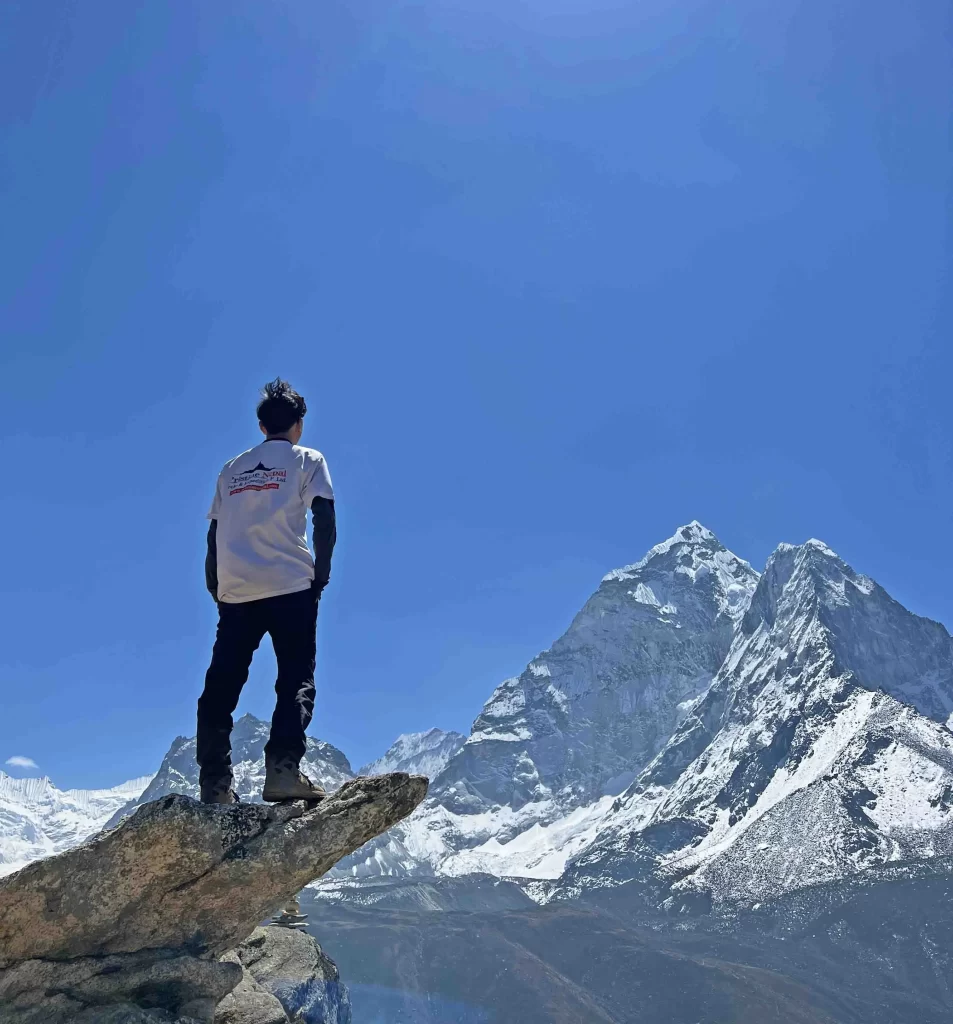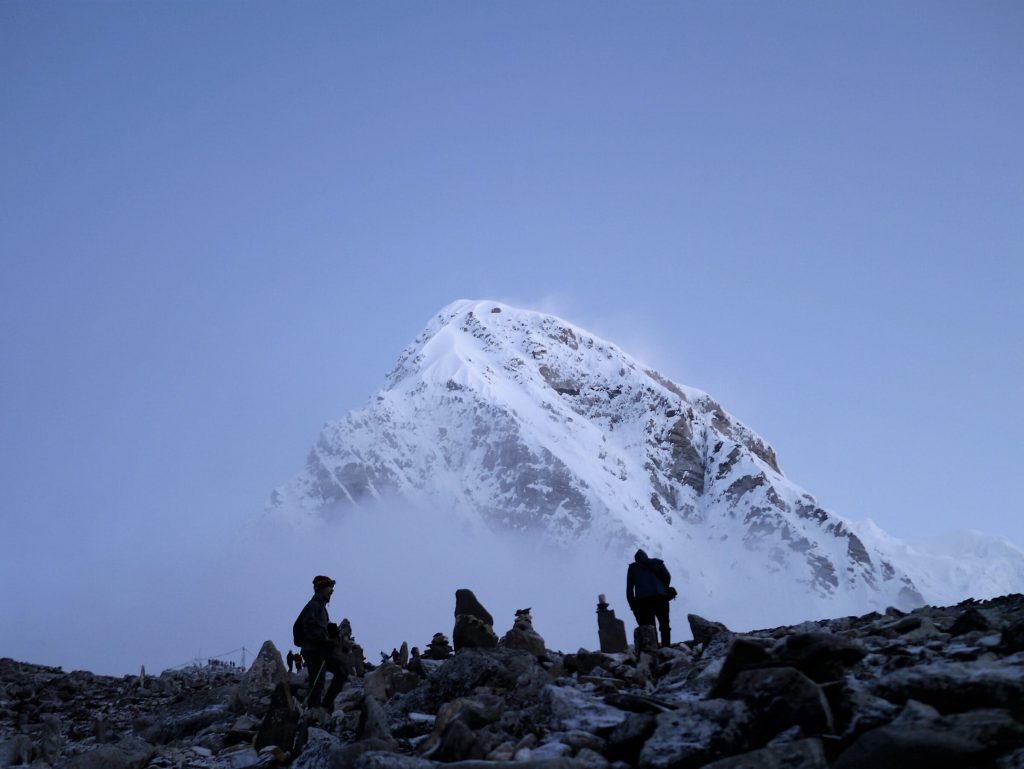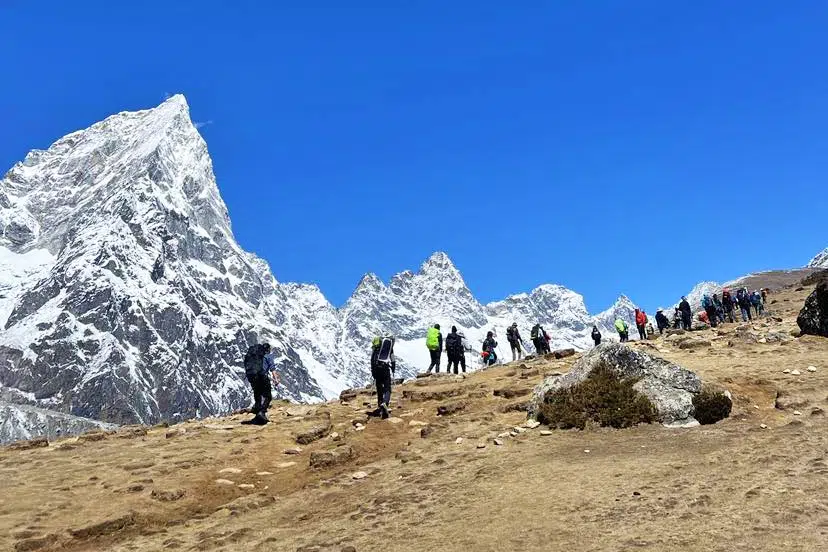The Everest Base Camp trek poses a question in the hearts of trekkers, travelers, and wanderers alike: how difficult is Everest Base Camp trek? While the trek to witness the world’s highest mountain, Mount Everest, is indeed demanding, it is not insurmountable. Standing at an elevation of 5,545 meters (18,192 feet) above sea level is a formidable feat.
When it comes to the difficulty level, it is essential to set realistic expectations. The Everest Base Camp trek is considered a challenging trek that requires physical fitness, stamina, and mental determination. The terrain is varied, ranging from well-marked trails to steep ascents and descents. Altitude is a significant factor, with the trek reaching a maximum elevation of about 5,364 meters (17,598 feet) at the Everest Base Camp.
The trek involves long days of walking, typically averaging around 6-7 hours of trekking per day. Some sections may be steep and demanding, requiring endurance and strength. However, with proper physical preparation and a gradual ascent, the trek is achievable for individuals with a reasonable level of fitness.
While the Everest Base Camp trek is challenging, it is important to remember that thousands of trekkers successfully complete it each year. With the right mindset, preparation, and support from experienced guides and porters, you can overcome the difficulties and accomplish this remarkable adventure.
Let’s dive more into the topic and find out the difficulty of the Everest Base Camp Trek in details.
How long will it take to complete the Everest Base Camp?

“Completing Everest Base Camp Trek depends upon how you prepared and trained for it.”
The duration to complete the Everest Base Camp trek typically ranges from 12 to 14 days. This duration includes trekking to and from the base camp, as well as acclimatization days. However, it’s important to note that the actual time required may vary depending on factors such as the chosen itinerary, individual fitness level, weather conditions, and the pace of the trek. Some trekkers may opt for shorter or longer itineraries based on their preferences and availability of time. It’s recommended to consult with experienced trekking agencies or guides to determine the most suitable itinerary for your specific needs and ensure a safe and enjoyable experience on this iconic journey.
The trek typically begins with a scenic flight from Kathmandu to Lukla, followed by several days of trekking through the picturesque Khumbu region. The route passes through vibrant Sherpa villages, crosses suspension bridges, and offers stunning views of majestic peaks, glaciers, and alpine landscapes and ultimately to the base camp of the Mount Everest.
The total distance covered during the trek is approximately 130 kilometers (80 miles) round trip. And, in general, you have to walk almost 5 hours a day covering almost 10km a day or even more depending on itinerary, which can be hard for any kinds of trekkers.
Everest Base Camp Trek Difficulty: Altitude
Altitude is a significant factor that contributes to the difficulty level of the Everest Base Camp trek. As trekkers ascend higher into the Khumbu region, the altitude increases, and the air becomes thinner. This decrease in oxygen levels can pose challenges to the human body and require proper acclimatization.
The maximum altitude reached during the Everest Base Camp trek is at Kala Patthar, standing at an elevation of 5,545 meters (18,192 feet). This is a considerable height that demands physical fitness, mental resilience, and a well-managed acclimatization process.
While altitude poses a challenge during the Everest Base Camp trek, with proper preparation, acclimatization, and adherence to recommended guidelines, trekkers can overcome these difficulties. It is essential to listen to your body, take the necessary rest, and consult with experienced guides or trekking agencies who can provide guidance and support throughout the journey. With the right precautions and a respectful approach to the altitude, trekkers can fully enjoy the awe-inspiring landscapes and achieve their goal of reaching the base camp of the world’s highest peak.

How to train for Everest Base Camp Trek?
Being healthy always benefits you in many ways and when talking about the EBC trek then it is compulsory for you. You will be testing your physical and mental health during trek. High altitude with very low air pressure can give some hard time. Prepare your body to bear those high altitude and long hikes.
Training for the Everest Base Camp trek is crucial to ensure that you are physically prepared for the challenges of the trek and able to enjoy the experience to the fullest. Here are some guidelines to help you train effectively:
Cardiovascular Endurance: Focus on activities that increase your cardiovascular fitness, such as running, jogging, cycling, or swimming. Aim to build your endurance gradually by incorporating longer and more intense workouts into your routine. This will help you cope with the sustained physical exertion of trekking at higher altitudes.
Strength Training: Strengthening your muscles, particularly your legs and core, will enhance your overall trekking performance. Include exercises like squats, lunges, step-ups, and planks in your training regimen. You can also incorporate weightlifting or resistance training to build muscular endurance.
Hiking and Uphill Trekking: Simulate the demands of the Everest Base Camp trek by including regular hikes and uphill trekking in your training. Seek out trails with varying terrains and inclines to challenge yourself. Gradually increase the distance and elevation gain to progressively build your stamina and leg strength.
Pack Weight Training: As you will be carrying a backpack during the trek, gradually introduce weight to your training routine. Start with a light backpack and gradually increase the load over time. This will help you get accustomed to the added weight and improve your endurance.
Interval Training: Incorporate interval training sessions into your routine to improve your overall fitness level and prepare for the varied terrain of the trek. Alternate between periods of high-intensity exercise and active recovery. For example, you can alternate between jogging and sprinting or cycling at different speeds.
Mental Preparation: Trekking at high altitudes can be mentally challenging. Practice mental resilience and develop a positive mindset by incorporating meditation, visualization techniques, or mindfulness exercises into your training. This will help you stay focused, motivated, and mentally strong during the trek.
Gradual Progression: It’s important to gradually increase the intensity, duration, and difficulty of your training sessions. This allows your body to adapt and reduces the risk of injuries. Listen to your body and avoid overexertion or pushing yourself too hard too soon.
Remember to consult with a healthcare professional before starting any new exercise program, especially if you have any pre-existing health conditions. Additionally, consider working with a qualified trekking guide or fitness trainer who can provide personalized guidance based on your fitness level and goals.
By following a well-rounded training program that incorporates cardiovascular endurance, strength training, hiking, mental preparation, and gradual progression, you will be better equipped to tackle the physical demands of the Everest Base Camp trek and fully enjoy this incredible adventure in the Himalayas.
Best season to do Everest Base Camp trek:

“Trekking Everest Base Camp in Autumn season.”
Depending on which month you trek, the paths can get easy as well as hard. The weather at Everest base camp plays vital role in selection of time to trek in Everest base camp. When talking about trekking in Nepal, Spring and Autumn season is considered the best season. From my experience, for beginners, Autumn is more suitable. Whereas, if you are thinking of trekking in the monsoon and winter season, then planning’s need to be made for the itinerary, accommodations, and foods too.
Look at the climate table for more detailed information about seasons in EBC:
| Month | Average Temperature | Seasons | Weathers |
| March 19-June 20 | 15°C at Day and -10°C at night | Spring season | Warm at day, clear blue sky, lush forests |
| June 21- Sep 22 | 17°C at daytime & 5°C at night | Summer season | Too much fog/mist. Slippery roads and muddy. |
| Sep 23- Dec 21 | 20°C at day & -10°C at night | Autumn season | Dry winds, warm and clear blue sky |
| Dec 22- March 20 | 15°C at day and -17°C at night | Winter season | heavy snowfalls possibilities, extreme cold at night. |
Some FAQs regarding Everest Base Camp Trek Difficulty
What are the 3 hardest days on Everest base camp?
At the start of the trek, you will embark on an ascent from 1400m to 2800m, which sets the tone for the entire Everest Base Camp journey. These initial days play a crucial role in determining the overall difficulty of the trek. Successfully navigating through these days sets the stage for a potentially less challenging experience throughout the trek. While the entire two-week duration can be demanding, there are specific days that stand out for their level of difficulty. Here are the following days that you should prepare yourself for:
- The second day (trekking to Namche Bazaar)
On the second day of the trek, trekkers face one of the most physically demanding sections. The journey from Phakding to Namche Bazaar involves a steep ascent taking approximately of 6-8 hours of walking, testing the endurance and strength of even the fittest individuals. The trail meanders through rugged terrain, crossing suspension bridges and dense forests. The altitude gain is significant, and it is crucial to pace oneself and allow time for acclimatization.
- The fourth day (trekking to Tyangboche)
The fourth day presents another challenging stretch on the Everest Base Camp trek. From Namche Bazaar, trekkers continue their ascent towards Tyangboche. The trail becomes steeper, and the air thinner as the altitude increases.
The initial section of the trail offers a delightful experience with its smooth path and captivating views of Mount Everest. The wide and well-maintained trail maintains a consistent elevation, providing trekkers with a panoramic view of the picturesque Lukla valley to the south and stunning vistas in the North-East direction. After enjoying this scenic stretch, you will embark on a descent of approximately an hour towards Phungi Thanga, where a well-deserved lunch break awaits.
However, the real challenge begins when you face a steep uphill climb of approximately two hours towards Tyangboche. The path becomes noticeably steep and demanding, presenting a significant physical test. The uphill ascent requires stamina and determination, as it can prove to be a strenuous endeavor.
- The eighth day (trekking from Lobuche to Everest base camp and back to Gorakshep)
The eighth day is undoubtedly one of the most demanding phases of the trek. Trekkers push themselves from Lobuche to Gorakshep, then proceed to Everest Base Camp before returning to Gorakshep again. The long hours of trekking at high altitudes require exceptional endurance and mental resilience. The thin air poses a challenge, and every step demands effort. However, the sense of accomplishment upon reaching Everest Base Camp is unparalleled, making the arduous journey worthwhile.
What’s harder, Kilimanjaro or Everest Base Camp trek?
In terms of difficulty, trekking to Kilimanjaro is harder than trekking in Everest Base Camp. The success rate for trekking in Kilimanjaro is 45% while EBC has a 90% success rate. Both can be challenging trek for you but we have some points that can argue that Kilimanjaro trek is harder than Everest base camp trek. They are:
- Kilimanjaro presents the elevation of 5,895m whereas Everest base camp has maximum elevation of 5364m.
- Night time summit hike can be very challenging
- Gaining altitude faster and less time to accommodate
However, both treks demand physical fitness, mental resilience, and proper acclimatization. The choice between Kilimanjaro and Everest Base Camp depends on personal preferences, altitude tolerance, and the type of adventure one seeks.
What percentage of people make it to Everest Base Camp?
Approximately 65% of trekkers successfully reach Everest Base Camp. The challenging nature of the trek, including issues like improper acclimatization, high altitude, and low atmospheric pressure, poses difficulties for many individuals attempting to complete the 14-day journey. However, with the invaluable guidance of an experienced guide, most of these obstacles can be overcome, increasing your chances of being among the 65% who successfully conquer Everest Base Camp.
Why is there no building on the base camp of Mount Everest?
Building a concrete structure at such a high elevation can be very challenging. Doing a labor task at such height in low air pressure is true challenge. And due to the natural difficulties, the base is not permanent and is shifted once in a while to scape the natural difficulties. Due to which there is no building on the base camp of Mount Everest.
How to visit Everest base camp with a minimum budget in 15 days?
One think is true that Nepal is not an expensive country. If you do cost break down of Everest base camp properly then you can successfully complete the trek in minimum cost.
Everest base camp can be a budget trip if you select right package for you. Or you can also choose service trek, which allows you to pay yourself at the spot.
Does acclimatization affect Everest Base Camp Trek Difficulty?
Yes, acclimatization does affect Everest Base Camp Trek Difficulty. It is very important while doing the Everest Base Camp trek. Normally, you will have 2 days of acclimatization day in the Everest Base Camp Trek package or you can customize your trip too.
Do I need a guide and a porter to hike to Everest Base Camp?
While it is technically possible to trek to Everest Base Camp alone, it is highly recommended, especially for those new to trekking, to not embark on the journey solo. Even if you have prior experience with hiking, trekking in the Everest region presents unique challenges that can make it highly unpredictable, with weather being a primary factor. The weather conditions in the region can change rapidly, posing risks and difficulties.
Beyond weather considerations, other factors such as high altitude, low atmospheric pressure, and cold temperatures can become formidable adversaries, potentially leading to altitude sickness and other health issues. Having a knowledgeable guide and a porter by your side significantly enhances your safety and comfort during the trek.
If you have a guide then you will not be at risk of getting lost primarily and a guide will share a lot of information and stories to you about the places you see. Every certified guide knows how to prevent altitude sickness and basic first aid knowledge which can eventually save your life.
A guide is not just a person who shows a path, a guide is your friend, a navigator, a first aider, and source of knowledge. More over a guide can make your journey very memorable, fun, informative, and most importantly safe.
While it is possible to hike to Everest Base Camp independently, the complexities and potential risks involved make the presence of a guide and porter highly beneficial, ensuring a safer and more enjoyable experience for trekkers.
Will I be safe during Everest Base Camp Trek?
Yes, if you are with a guide then safety will be the main priority for guides. However, if you are doing solo trekking then you are on your own and may not be safe. But still, you can do evacuation at the time of danger.
In conclusion, the Everest Base Camp trek is undoubtedly a challenging endeavor that requires physical fitness, mental resilience, and careful preparation. The combination of high altitudes, rugged terrain, and long days of trekking makes it a demanding adventure. However, with the right mindset, proper acclimatization, and adequate training, this trek is achievable for individuals with moderate fitness levels and a determination to succeed. Get in touch with us for proper trek planning and preparations.

